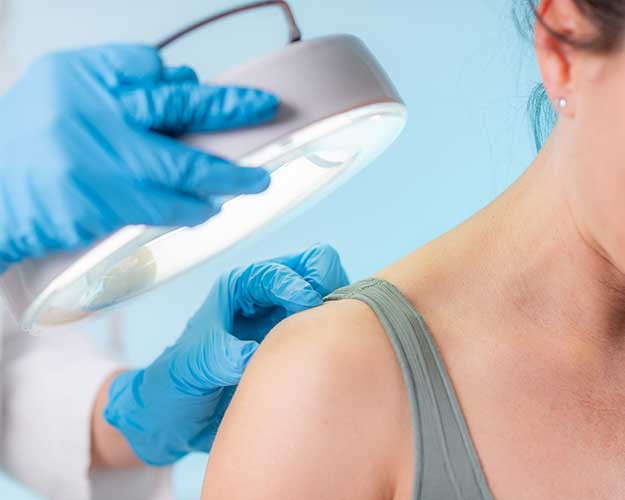Basal Cell Carcinoma Skin Cancer Signs, Symptoms and Treatments
Contact Us
What is basal cell carcinoma?
Basal cell carcinoma is the most common type of skin cancer. The majority, nearly 80 percent, of all non-melanoma skin cancers are basal cell. These cells are found in the deepest part of the outer layer of the skin, known as the epidermis, that we can see and touch. Basal cells produce new skin cells and push older cells toward the skin’s surface, where they die and are shed or sloughed off. Cancer occurs when basal cells begin to grow out of control.
Back to Top
What are the signs and symptoms of basal cell carcinoma?
Basal cell carcinomas develop most often on areas of the skin that are exposed to the sun, such as the head, face, neck and arms, but can occur anywhere on the body. They tend to grow slowly and rarely spread to other parts of the body. However, if left untreated, basal cell carcinoma can grow and invade bones or other tissues beneath the skin or other areas of the body.
Signs of basal cell carcinoma can vary from person to person and are more visible on people with lighter-colored skin. Warning signs include small, shiny bumps or growths that appear red or pink. In people with darker-colored skin, these areas may appear brown or blue. They may appear slightly elevated, have rolled edges and/or an indent in the center. They may itch or ooze and can bleed after shaving. Many of these symptoms can also indicate conditions other than cancer. See your medical doctor if any of these symptoms persist beyond a few weeks.
Back to Top
How is basal cell carcinoma diagnosed?
Diagnosing basal cell carcinoma begins with a physical examination so that your doctor can evaluate the symptoms you are experiencing. Your doctor may also feel for bumps on nearby lymph nodes, which can indicate that the cancer has spread. Other types of testing and imaging scans may be necessary to make a definitive diagnosis.
Additional information to confirm a diagnosis and how advanced the disease is can be obtained through a more in-depth examination of the skin. The doctor may perform a skin biopsy to remove all or part of the affected area(s) for examination under a microscope to look for any precancerous or cancerous cells. Sometimes a biopsy will remove the entire tumor without the need for any further treatment.
Back to Top
What causes basal cell carcinoma?
Basal cell skin cancers are caused most frequently by repeated and unprotected skin exposure to ultraviolet (UV) rays. UV rays occur naturally in sunlight, as well as from man-made sources such as tanning beds. Without adequate protection, UV rays can damage the DNA inside skin cells and cause changes in how these cells function.
Back to Top
Is basal cell carcinoma genetic?
Multiple genetic factors and pathways may contribute to an increase in the risk of basal cell carcinoma. It is best to talk with your doctor regarding any genetic predisposition to these cancers.
Back to Top
Is basal cell carcinoma curable?
Most basal cells are curable when found and treated in early stages. However, basal cell carcinoma can recur (come back) even after successful treatment. It can recur in the same place or in other areas of the body. Anyone diagnosed with any type of skin cancer is at higher risk of developing skin cancers in the future, so it is important to continue watching for warning signs.
Back to Top
How is basal cell carcinoma treated at FCS?
Each patient and each cancer is unique. At FCS, physicians develop a personalized treatment plan in partnership with patients. Treatment options depend on a number of factors, including the specific type and stage of cancer, possible side effects, and the patient’s overall health and personal preference. Surgery to remove the cancerous cells and healthy tissues surrounding them is the most common treatment for basal cell carcinoma. Other treatments can include freezing the cancer cells with liquid nitrogen to remove cancerous cells, oral medication, immunotherapy, radiation therapy, IV, and topical medications.
Back to Top
What are common risk factors for basal cell carcinoma?
Prolonged exposure to UV rays, either from the sun or from artificial sources, greatly increases the risk of skin cancer. Daily use of sunscreen with a sun protection factor (SPF) of 30+ applied to all exposed areas of the body can greatly reduce risk. Use of tanning beds should also be avoided.
Other risk factors include:
- Having fair or pale skin and/or red hair
- Family history of skin cancer
- The presence of atypical moles, which appear raised above the skin surface with ragged or blurred borders
- Radiation therapy to treat acne or other skin conditions
- Weakened immune system
- Exposure to arsenic
Are there screening tests for basal cell carcinoma?
Skin cancers are cancers that we can see and feel. Monthly self-exams and annual skin checks by a dermatologist are vital to early detection. Spots, blemishes, freckles and moles are signs of sun-damaged skin. They are usually harmless, but if you notice them changing or if something doesn’t look or feel right, it is important to reach out to your medical doctor or dermatologist.
Back to Top
What does basal cell carcinoma look like?
Signs of basal cell carcinoma can vary from person to person and are more visible on people with lighter-colored skin. Warning signs include small, shiny bumps or growths that appear red or pink. In people with darker-colored skin, these areas may appear brown or blue. They may appear slightly elevated, have rolled edges and/or an indent in the center. They may itch or ooze and can bleed after shaving.
Back to Top
Does basal cell carcinoma itch?
Basal cell carcinoma can itch, although it is rarely painful.
Back to Top



























